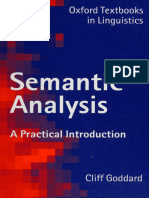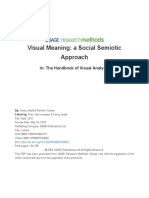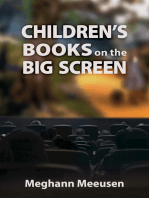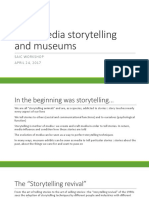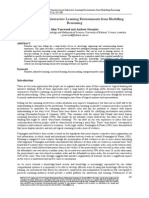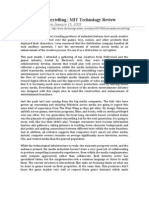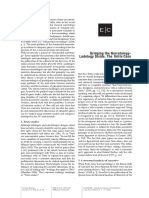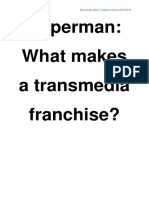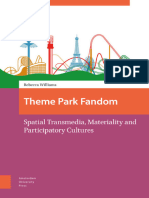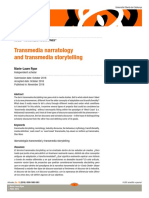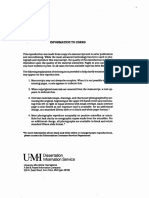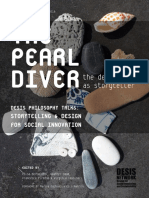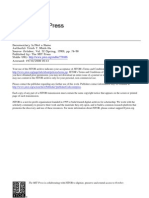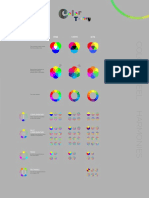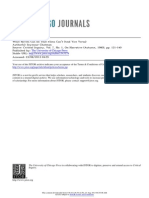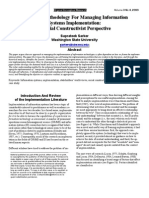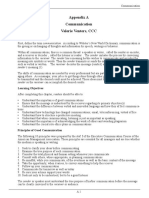100%(1)100% found this document useful (1 vote)
371 viewsTransmedia Storytelling Total Work of Art
Transmedia Storytelling Total Work of Art
Uploaded by
Andra LianaThis document provides an analysis of the relationships between transmedia storytelling (TMS) and the Gesamtkunstwerk or "total work of art". It begins by defining TMS based on Henry Jenkins and distinguishing between intracompositional and intercompositional works. Gesamtkunstwerk is defined based on Richard Wagner's conception as unifying different art forms into a single work. The document then examines the similarities between TMS and Gesamtkunstwerk, arguing that while they differ stylistically, they both express a need to cross borders between media and art forms. Specifically, it notes that TMS relies heavily on intermediality, while the Gesamtkunstwer
Copyright:
© All Rights Reserved
Available Formats
Download as PDF, TXT or read online from Scribd
Transmedia Storytelling Total Work of Art
Transmedia Storytelling Total Work of Art
Uploaded by
Andra Liana100%(1)100% found this document useful (1 vote)
371 views13 pagesThis document provides an analysis of the relationships between transmedia storytelling (TMS) and the Gesamtkunstwerk or "total work of art". It begins by defining TMS based on Henry Jenkins and distinguishing between intracompositional and intercompositional works. Gesamtkunstwerk is defined based on Richard Wagner's conception as unifying different art forms into a single work. The document then examines the similarities between TMS and Gesamtkunstwerk, arguing that while they differ stylistically, they both express a need to cross borders between media and art forms. Specifically, it notes that TMS relies heavily on intermediality, while the Gesamtkunstwer
Original Description:
Transmedia storytelling Total work of art
Original Title
Transmedia storytelling Total work of art
Copyright
© © All Rights Reserved
Available Formats
PDF, TXT or read online from Scribd
Share this document
Did you find this document useful?
Is this content inappropriate?
This document provides an analysis of the relationships between transmedia storytelling (TMS) and the Gesamtkunstwerk or "total work of art". It begins by defining TMS based on Henry Jenkins and distinguishing between intracompositional and intercompositional works. Gesamtkunstwerk is defined based on Richard Wagner's conception as unifying different art forms into a single work. The document then examines the similarities between TMS and Gesamtkunstwerk, arguing that while they differ stylistically, they both express a need to cross borders between media and art forms. Specifically, it notes that TMS relies heavily on intermediality, while the Gesamtkunstwer
Copyright:
© All Rights Reserved
Available Formats
Download as PDF, TXT or read online from Scribd
Download as pdf or txt
100%(1)100% found this document useful (1 vote)
371 views13 pagesTransmedia Storytelling Total Work of Art
Transmedia Storytelling Total Work of Art
Uploaded by
Andra LianaThis document provides an analysis of the relationships between transmedia storytelling (TMS) and the Gesamtkunstwerk or "total work of art". It begins by defining TMS based on Henry Jenkins and distinguishing between intracompositional and intercompositional works. Gesamtkunstwerk is defined based on Richard Wagner's conception as unifying different art forms into a single work. The document then examines the similarities between TMS and Gesamtkunstwerk, arguing that while they differ stylistically, they both express a need to cross borders between media and art forms. Specifically, it notes that TMS relies heavily on intermediality, while the Gesamtkunstwer
Copyright:
© All Rights Reserved
Available Formats
Download as PDF, TXT or read online from Scribd
Download as pdf or txt
You are on page 1of 13
Beyond media borders: Transmedia
Storytelling and the Gesamtkunstwerk
Liana Voinea VU University Amsterdam
Voorburgstraat 238 Faculty of Arts
1059 VD Amsterdam Comparative Arts and Media Studies
Tel.: 0616164750 Transmedia Storytelling
Student number: 2533846 Dr. J.I.L. Veugen
E-mail address: L.voinea @student.vu.nl
December 13
th
, 2013
Table of Contents
Abstract ................................................................................................................................................... 1
1. Introduction ..................................................................................................................................... 1
1.1. What is TMS? ........................................................................................................................... 2
1.2. What is Gesamtkunstwerk? .................................................................................................... 2
2. Relations between TMS and Gesamtkunstwerk ............................................................................. 3
2.1. TMS as intermedial .................................................................................................................. 4
2.2. Gesamtkunstwerk as TMS ....................................................................................................... 6
2.3. TMS as transmedial Gesamtkunst ........................................................................................... 6
2.4. Using media for immediacy and unification ............................................................................ 7
3. Conclusion ....................................................................................................................................... 8
Reference list ......................................................................................................................................... 10
1
Abstract
This essay investigates if there is a solid base for the comparison made by some authors between
Transmedia Storytelling and the Gesamtkunst. It analyses the similarities; there are also many
differences, some of which are briefly stated, but they are not the subject matter of this essay. The
chosen theory of the Gesamtkunst belongs to Mathew Wilson Smith, who sees it as an art form born
in the Romantic period that reappears ever since in different types of utopian imaginary worlds. He
has briefly suggested that some TMS (he doesnt use this word, but this is what he describes)
phenomena pertain to the same ideal; this essay tries to give some arguments for this. It approaches
the similarities both in form and content and emphasizes the need to look further than apparent
stylistic differences in comparing TMS and Gesamkunst. It shows how much TMS, a transmedia
phenomenon, relies on intermediality. From the other direction, it challenges the idea that the total
work of art is, as usually considered, only intermedial and multimedial, based on an interpretation of
Matthew Smith. Then, it points up the cultic dimension of both TMS and Gesamtkunst and proposes
seeing TMS as a total world made of interlocking performances. The last chapter brings further
similarities in terms of technical realization, as both forms usually rely on the newest technologies
and media in order to become more immersive and seem immediate. In the last sections the study
observes that they both use a created distance between the public and the product, which aims to
make the first eager to pulverize it.
Keywords: TMS, Gesamtkunstwerk, total work of art, intermedial, mixed-media, Richard Wagner,
Henry Jenkins, Christy Dena, Matthew Wilson Smith
1. Introduction
Gesamtkunstwerk is a term which is becoming more popular in the discussions about transmedia
storytelling (TMS)
1
. Some authors focus on the stylistic similarity of different media used to express a
single narrative. They either consider it an intriguing historical precursor
2
or an expression of the
same transhistorical desire of transgressing borders between different qualified
3
media or between
the real world and media.
4
Others take into consideration the relations to politics, economy, society
and culture, regarding TMS as dangerously surging from the Wagnerian utopian dream.
5
However, no thorough comparison of the two concepts has been realized. Is there indeed, as
most of the authors claim but dont develop, behind the apparent differences, a similarity between
the two phenomena? The scope of this paper doesnt allow it to extensively answer the question but
1
Giovagnoli 2011.
2
Rose 2011 a.
3
I borrow this terminology from Lars Ellestrom, for whom the qualifying aspect is one of the three defining
aspects of the medium (the other being the basic and the technical one). Qualified media can be art (ex:
painting/ performance/ sculpture) or non art (e-mail, tweet, trailer). (Ellestrom 2010)
4
Dena 2009, p. 328.
5
Matthew Smith says the Gesamtkunstwerk shouldnt continue to inspire us (Smith 2007, p.6) as it is a dream
of mass utopia mediated by the machine (p.47) and gives the cross-media example of Disney as a follower of
the Gesamtkunst.(p. 122).
2
to point out some intersection points. I do not argue an identity of concepts, but show possible
reasons for their association. I believe it is important to see each aesthetic form in a historical
context and Gesamtkunst is one of the most inciting connections to TMS.
First of all it must be said that both TMS and the Gesamtkunst have been interpreted
differently, by theoreticians and practitioners alike. The definitions I depart from are given by the
first ones who coined the two terms: Henry Jenkins and Richard Wagner respectively.
1.1. What is TMS?
Transmedia storytelling is a term popularized by Henry Jenkins in 2003 that describes
a process where integral elements of a fiction get dispersed systematically across multiple
delivery channels for the purpose of creating a unified and coordinated entertainment
experience. Ideally, each medium makes its own unique contribution to the unfolding of the
story.
6
,7
Christy Dena and Henry Jenkins make two basic distinctions in the realm of TMS. Dena
differentiates between intracompositional(a single composition/text is expressed through multiple
media) and intercompositional works (where the different media are themselves compositions).
Jenkins separates the Hollywood based model of transmedia and the Alternate Reality Game
(ARG).
8
I prefer Denas concepts, as they are more general: under the name of intracompositional,
other phenomena except for ARGs can be used.
This essay is based also on the idea that TMS is not something completely new, which was
pointed out by many scholars, mostly perhaps by Henry Jenkins.
9
1.2. What is Gesamtkunstwerk?
This term, translated usually as total work of art, was coined by Wagner in 1849 in his essays Art and
Revolution and The Artwork of the Future and described as follows:
The great United Art-work, which must gather up each branch of art to use it as a mean,
and in some sense to undo it for the common aim of all, for the unconditioned, absolute
portrayal of perfected human nature,this great United Art-work he cannot picture as
depending on the arbitrary purpose of some human unit, but can only conceive it as the
instinctive and associate product of the Manhood of the Future.
10
6
Jenkins 2007.
7
Furthermore, confronted with a lack of a sophisticated enough definition, Jenkins says: There is no
transmedia formula. Transmedia refers to a set of choices made about the best approach to tell a particular
story to a particular audience in a particular context depending on the particular resources available to
particular producers, (Jenkins 2011 b.)
8
Jenkins 2011 b.
9
I think the best example Jenkins gives (2006, p. 119) is the story of Jesus in the Middle Ages, which was told
accross multiple media (art forms and senses).
10
Wagner 1849.
3
What Wagner means here, as can be better understood from the whole text, is that, in order to
stimulate the return to the organic, total art (of the Greeks), from the fragmented state of the
current society, the artist has to unify the arts into a single piece, at the expense of which each of
them will lose their individuality. The actors act though dance and song, and so drama, dance and
music cannot be separated. Furthermore, language is musicalized at the expense of its meaning. This
accounts for the intermedial part of the work. However, in the implementation of his ideal, Wagner
also used an orchestra and landscape paintings, which make the total work of art also multimedia
11
.
As the quotation shows, the Gesamtkunstwerk (which I will abbreviate G) is not only a stylistic
procedure but also an expression of a social ideal the (recovery of supposedly lost organic) unity of
the social body and of life and art. This is showed by the term gesamt itself, which can be translated,
as Matthew Smith says
12
, in various ways: total, combined, unified, communal or collective.
13
2. Relations between TMS and Gesamtkunstwerk
It is not my intention to say that TMS is G or viceversa. The differences are considerable, as can be
seen from their definitions. Stylistically speaking, TMS is not defined by intermediality, but, as well
see in section 2.1, which expands the already formulated idea that both express the same need of
convergence and of border crossing
14
, it is closely related to it. Conversely, the G seems different
from TMS as it is a combination of intermedial and multimedial
15
, not transmedial relations;
however, section 2.2 will argue that, in a small measure, this is not exact.
In economic, social or technological terms to name just a few, the two have many
differences: TMS is a demand for the commercial industry of entertainment while the G stems from a
romantic ideal of anti-capitalism and an aesthetic existence; TMS usually surrounds the viewer from
many media channels and locations while the G is clearly more limited; the internet and videogames
create deeper immersion and participation in TMS than in G etc.
However, there are similarities also in these respects. The third subsection will treat the common
cultic aspect and the last section - the technical similarities.
11
I use the term multimedia here in the general sense of one work composed from multiple media.
12
Smith 2007.
13
Wagner (1849) acknowledges that the artist cannot be its creator, as only the perfected human community
of the future can. However, the artist can offer an image of that future art work, as his imaginative faculty
comes from the nature-craving instinct.
14
Dena 2009, p. 328.
15
Dena (2009 p.91-92) makes a mistake saying that Wagners Gesamtkunstwerk is only multimedial and not
intermedial, interpreting it as an usual opera, which Wagner precisely didnt want to.
4
2.1. TMS as intermedial
TMS, encouraged by digitalization and the Internet, crosses divides between 1) different qualified
media and 2) qualified media and realms usually placed outside them.
2.1.1. The first type of intermediality will be analysed in this and the following two
paragraphs. One aspect of it, as Frank Rose
16
notes, is games that become stories and vice versa. This
is shown at macro-level in TMS franchises, where the story often provides gaps to stimulate creative
thinking and at micro-level in the ARGs that usually present the fans a puzzle to be solved.
Furthermore, as Jenkins notes, the move toward digital effects in film and the improved
quality of video game graphics means that it is becoming much more realistic to lower production
costs by sharing assets across media.
17
There are games that display either footage shot during the
film production, either game rendered videos that feature the voices of the film cast; one example is
Enter the Matrix.
18
However, there are still significant difficulties in sharing assets across media,
particularly between game and film, as Casey ODonnell shows
19
.
Even if there is diversity, there is considerable need of audio-visual style consistency
throughout TMS. As the media are split and require people to actively engage in finding and putting
them together, similarities provide the sense of unity that is the final purpose. Even if there are some
exceptions to this (like the Matrix comics drawn by the Wachowskis that dont bear any resemblance
to the movie
20
, or the Animatrix, where the characters appearance is completely changed -
animized), usually, style consistency is very important, as can be seen with The Wizard of Oz,
Disney TMS productions, Star Wars, Assassins Creed etc.
2.1.2. The second type of intermediality in TMS, between qualified media and realms usually
placed outside them, can be seen between texts and paratexts, marketing and audience, fiction and
real life. As regards TMS as intermedial between text and paratext, or entertainment and marketing,
much has already been said. Johnatan Gray wrote a book
21
describing both fans and critics
production (fan fiction, fan wiki, reviews) and other production (trailers, toys, other commodities) as
paratexts of vital importance to the text, urging us to reconsider them.
Some productions incline more to the paratext side. For example, Star Wars toys, as Jenkins
and Gray discuss
22
, have perhaps had vital importance in keeping the series alive in the long breaks.
But they didnt add anything to the movie, being rather an adaptation. Also, they were probably not
16
Rose 2011, p.6.
17
Jenkins 2003.
18
The Matrix 101.
19
ODonnell 2011.
20
Wachowski, Lara and Andy 2003.
21
Gray 2010.
22
Jenkins 2010.
5
conceived from the start as a complement to the TV series. They stand probably in between TMS
extension and paratexts, as most of the paratexts, or at least the successful ones.
Others are closer to a TMS extension than to paratexts, like the media that followed the
Matrix, which Gray calls paratexts but many others, like Jenkins, consider texts in TMS
23
. The
classification seems to depend on the additive comprehension that these media bring or not. Or, like
Keith Stuart says, good paratexts as Why so Serious? have totally pulverised the distinction between
marketing and narrative
24
.
In what concerns the blurring between audience and marketing, there is clearly an
agreement that this is happening. Both cultural media and critical theory studies have noticed this,
but they do not always agree if there is one dominant force. Henry Jenkins says that Web 2.0 is a
place of both pleasure and exploitation, both a space of participation and a space of
commodification, both a space of capitalist and gift economy.
25
Christian Fuchs, coming from
critical studies, considers participation a political concept and thus incompatible with
commodification. Also, from his political and economic perspective, the fans are being exploited, but
in such an insidious manner, that they dont even notice many times
26
. Henry Jenkins admits, in
Spreadable Media, that social media works to sustain the traditional, insistent sticky model.
27
However, there is a great degree of risk in relying upon the fans to market the product, as one cannot
guarantee virality, so I agree with Jenkins that web 2.0 involves more participation and introduces a
gift economy. Leaving the public to respond might get you nowhere or somewhere farther than
without any feedback at all.
As for the third example of TMS intermediality, between real life and fiction, the best
examples come from ARGs, which use real life as a platform. ARGs make real life part of a story. In
the case of ARGs that claim they are not fiction, like the Truth about Marika, the degree of
hybridisation depends on the player, with some less involved, realizing the story is not true, and
others more involved, mixing reality and fiction.
28
In the case of ARGs whose claim to be real is not so
important, like I love Bees, it is less likely to disappoint players in the end and most of the players
have the same degree of involvement.
23
Jenkins considers the Matrix games and other media released after the first movie as an example of TMS
(2006, pp. 93-131) while Gray (pp. 41-43) interprets them as paratexts (each text is a paratext for the others).
24
Stuart, Keith, comment in Rose 2011 b.
25
Jenkins 2011 a.
26
Fuchs 2011.
27
Jenkins, Henry, Sam Ford, and Joshua Green 2013, p. 9.
28
Waern 2009.
6
2.2. Gesamtkunstwerk as TMS
This section argues for viewing Wagners creations as TMS intracompositional phenomena. Willson
Smith has already showed the importance of the journey to Bayreuth for the meaning of the text
itself. He has explained why Wagner chose this city for his theatre and refused the proposals for
Munich, Berlin and Chicago: because Bayreuth, a little town, represented the antithesis of an
industrialized commercial culture; because it was very German (both as geography central - and
history no Romans conquered it) and finally because of its isolation which forced visitors to make
special journeys here. The pilgrimage furthered Wagners aspiration for Bayreuth to become a cultic
centre where visitors enter a mythical and mystic world.
29
Even if the choice was not perfect, as Wagner could have found, maybe, a town that showed
less the signs of capitalism, Bayreuth most of all succeeded to enact a pilgrimage that is of vital
importance to his artistic project as a whole.
The relationship between the pilgrimage and the opera is similar to the one between the
ARG Why so serious? and the Dark Knight movie about which Rose says that viewers were included in
the story before it started
30
. This suggests that art is not something without connection to reality but
that instead builds itself as a continuation of it.
2.3. TMS as transmedial Gesamtkunst
Both TMS and the total work of art are directed towards society, as much as possible as a whole, and
have cultic elements. As mentioned in the introduction, Wagner considered the ideal work of art a
social and collective one. Its roots are in mythology. Its manifestation is quasi-religious. Wagners
Parsifal, the only piece he has wrote especially for the theatre built to stage the Gesamtkunst, is a
religious work. Matthew Smith convincingly interprets it as a Eucharistic ritual that includes the
audience in its community of celebrants which is achieved by often making the main character,
Parsifal, to appear in the same entranced state induced to the spectators
31
.
However, Wagner used only character identification and pilgrimage to encourage the sense of
community and media convergence to represent the unification of society. Transmedia storytelling,
both in its components and in its totality, seems to take Wagners idea further. Its diverse media
mean that a varied audience will take part in it, from the one of the mainstream media (TV, film,
books) to the one of the niche media (videogames, comics, graphic novels). The use of social media
means that these people are now able to create or share content and information, be part of a story
or create one.
29
Smith, pp 24-26.
30
Rose 2011, p.12.
31
Smith 2007, p.42.
7
Mythology has always been important for Hollywood, but Star Wars marked the beginning of an
era where its incarnations are in different realms than the present, mostly in parallel or future worlds
like in phantasy and science fiction: Star Trek, Lord of the Rings, Harry Potter, Avatar etc. This new
wave has been prolific for TMS, for its main possibility is to render worlds, as Jenkins says.
32
Mythology is fruitful for TMS also because the latter needs archetypal characters and situations that
are easy to recognize, and thus keep the consistency of the dispersed story.
33
Both TMS and the Gesamtkunst encourage cult-like response through the totality of the world
presented. The relatedness of TMS to cult has already been suggested by Jenkins, who considers
Ecos criteria for the cult movie akin to those of TMS: a complete world, quotability, encyclopedicity
and polycentrism, which encourage the VUP (viewer/user/player) to construct his own fantasies
34
.
The cult in TMS may be expressed through modern pilgrimage, like the one in 1977 when Star Wars
fans camped for 6 weeks in front of the TCL Chinese Theatre, then went to Disneyland and finally to
the other premieres in different cities around the world. However, the rise of DVDs renders the
premiere journey less common while making the cult manifest mostly through obsessive consume.
Nevertheless, if the TMS or ARG mentions a real location, people will travel there in order to be
further immersed in the story, as proven for example in I love bees
35
or Why so serious
36
?
In this light it is also easy to understand Smith, who says that Disneys cross-media tactic creates
a total performance of a single mythical world
37
. Disneys example can be extrapolated, I think, to
many TMS franchises, whose most total components are MMOGs, ARGs, theme parks and movies
with heavy use of visual effects.
2.4. Using media for immediacy and unification
Another common feature for TMS and Gesamtkunst is that the separation of audience and narrative
is only made with the purpose of uniting them in the end. If TMS does this through different media,
Gesamtkunst does this by the technical manipulation of the theatrical apparatus.
Both TMS and Gesamtkunstwerk use the newest media available (and many times also have
significant contributions to them) in order to give a more immediate and immersive experience.
TMS usually requires a substantial budget for taking advantage of the newest technologies. There are
some examples, like The Wizard of Oz
38
, Lizzy Bennet Diaries, Fury of Solace, that dont conform to
this, but the most popular ones, like Disney productions, Why so serious? (ARG), I love bees (ARG),
32
Jenkins 2006 p. 114.
33
Jenkins 2006, p. 120.
34
Jenkins 2006, p. 98.
35
McGonigal 2007.
36
Rose 2011, p.10.
37
Smith 2007, p 122.
38
Henry Jenkins talks in various places (the most recent of which is Jenkins 2013) about the Wizard of Oz as an
early TMS because of its world building through several media.
8
Matrix (TMS), Assassins Creed (TMS), Dirty Works (TMS), do. 3D and special effects have commercial
success as they absorb the VUP more and so technical innovations like the Bullet time for Matrix are
not unusual, even if they are common to Hollywood in general. Many TMS projects also develop apps
that further the connection between the viewer and the narrative.
Also, as mentioned in the previous section, TMS makes extensive use of social media. The
process of TMS is one that is rationally created for any type of product, much like a mechanism, in
order to reach its multiple targets, and then left to grow organically:
What we need to do is figure out the story behind the brand, the place it wants to occupy in
the consumers mind, deconstruct it, make it relevant and reassemble it for the relevant
audiences, on the appropriate channels. Then, through social media, let the experience and
associations grow organically.
39
The same procedure is described by Wagner when he says that the artist should not leave
the traces of his work, as they would reveal a masterpiece of mechanism, even though the artwork
is in organic growth.
40
Wagner was a pioneer of technical changes in creating the impression of immediacy.
41
While
he dedicated much attention to the captivation of the public (as TMS does through the visual effects
mentioned), Wagner put a distance between the spectacle and the viewer not by sending him to
another medium with different protocols, but by lighting and distance. The stage was never so far
from the public as in the Festspielhaus; nor the contrast of light between the auditorium and stage so
strong. Wagner wanted to emphasize the distance between the stage and the spectators only in
order to make them more fascinated and eager to turn the represented ideal world real and thus
unify the real state of the society, which he saw as fragmented, with his ideal vision.
3. Conclusion
What I tried to emphasize in this essay is the need to look further than stylistic differences, which are
themselves conventional and limited. I tried to see how much TMS relies on intermediality (2.1.) as
well as if the total work of art is really, as usually considered, only intermedial and multimedial (2.2),
which, with the help of Matthew Smith, I argued it is not. I emphasized the cultic dimension of both
TMS and Gesamtkunst and proposed seeing TMS as a total world made of interlocking performances
(2.3.). In the last chapter I brought forward similarities in terms of technical realization, as both forms
rely usually on the newest technologies and media in order to become more immersive and seem
immediate. Also, I observed that they both use a created distance between the public and the
spectacle, which aims to make the first eager to pulverize it. (2.5.)
39
Baker, Dean quoted in Berelowitz 2011, p.4.
40
Wagner 1852.
41
The proscenium gave all a clear view of the stage, the deep pit and a second proscenium hid the orchestra,
the gaslights offered a better lighting of the stage and finally, the house lights were darkened during the
performance, channelling the attention to the stage. This last improvement made Smith call him the precursor
of cinema (Smith pp. 30-31.)
9
As I explained in the Introduction, I believe these clarifications might serve for shedding some
light into the confusion of both terms, which stems maybe from the fact that the two forms belong
to different time periods and were examined differently in cultural and critical theory studies
respectively.
My essay is schematic due to the lack of space and could easily be expanded, especially with a
braver answer to Matthew Wilson Smiths fear regarding the negative influence that Gesamtkunst
has on the entertainment today.
10
Reference List
Primary sources
Wachowsky, Lara and Andy, Bits and Pieces in The Matrix Comics Graphic Novel Vol. 1, (Burlyman
Entertainment)2003.
Secondary sources
Berelowitz, Marian, Transmedia Rising, March 2011.
<http://www.jwtintelligence.com/production/TransmediaRising_JWT_TrendReport_March201
1.pdf> [1 December 2013].
Dena, Christy, Transmedia Practice: Theorising the Practice of Expressing a Fictional World across
Distinct Media and Environments(Unpublished PhD dissertation) 2009.
<http://dl.dropboxusercontent.com/u/30158/DENA_TransmediaPractice.pdf> [1 December
2013].
Ellestrm, Lars, The Modalities of Media: A Model for Understanding Intermedial Relations. in: Lars
Ellestrm (ed.), Media borders, Multimodality and Intermediality, Basingstoke (Palgrave
Macmillan) 2010, pp. 11-48.
Fuchs, Christian, Against Henry Jenkins. Remarks on Henry Jenkins ICA Talk Spreadable Media,
2011. <http://fuchs.uti.at/570/ >[1 December 2013].
Giovagnoli, Max, Transmedia Storytelling. Imagery, Shapes and Techniques
2011.<http://beta.upc.edu.pe/matematica/portafolios/nmynt/book-by-max-giovagnoli-
transmedia-storytelling-imagery-shapes-and-techniques.pdf> [1 December 2013].
Gray, Jonathan, Show Sold Separately: Promos, Spoilers, and Other Media Paratexts, New York and
London (New York University Press) 2010.
Jenkins, Henry, Transmedia Storytelling. Moving Characters from Books to Films to Video Games Can
Make Them Stronger and More Compelling, 15 January 2003.
<http://www.technologyreview.com/news/401760/transmedia-storytelling/> [1 December
2013].
Jenkins, Henry, Convergence Culture: Where Old and New Media Collide New York and London (New
York University Press) 2006.
Jenkins, Henry, Transmedia Storytelling 101, 2007.
<http://henryjenkins.org/2007/03/transmedia_storytelling_101.html> [1 December 2013].
Jenkins, Henry, On Anti-Fans and Paratexts: An Interview with Jonathan Gray (Part Two) 8 March
2010. <http://henryjenkins.org/2010/03/on_anti-fans_and_paratexts_an_1.html>[1 December
2013].
Jenkins, Henry,SPREADABLE MEDIA, ICA Talk, 26-30 May 2011 a.
<http://www.slideshare.net/amandafo/ica-af-edits> [1 December 2013].
Jenkins, Henry Transmedia 202: Further Reflections, 1 August 2011 b.
<http://henryjenkins.org/2011/08/defining_transmedia_further_re.html>[1 December 2013].
Jenkins, Henry, Sam Ford, and Joshua Green, Spreadable Media: Creating Value and Meaning in a
Networked Culture, New York (New York University Press) 2013.
11
Jenkins, Henry, ALL OVER THE MAP: WHAT OZ THE GREAT AND POWERFUL CAN TEACH US ABOUT WORLD-
BUILDING, conference of International Society for Intermedial Studies, Cluj-Napoca, October 24-
26, 2013. <http://henryjenkins.org/2013/12/highlights-from-the-rethinking-intermediality-in-
the-digital-age-conference.html#sthash.gVJQaQgS.dpuf> [1 December 2013].
McGonigal , Jane, Why I Love Bees: A Case Study in Collective Intelligence Gaming in: K. Salen
(ed.), Ecologies of Games:Connecting Youth, Games, and Learnin, Cambridge, Massachusetts
(The MIT Press) 2007, pp. 199-227.
O'Donnell, Casey. Games Are Not Convergence: The Lost Promise Of Digital Production And
Convergence. Convergence: The Journal Of Research Into New Media Technologies 17 (2011)
3, pp. 271-286.
Rose, Frank, The Art of Immersion, New York and London (W.W. Norton & Company) 2011 a.
Rose, Frank, What Richard Wagner can teach us about storytelling in the Internet age, 5 August
2011 b, <http://www.deepmediaonline.com/deepmedia/2011/08/what-wagner-can-teach-us-
about-storytelling-in-the-internet-age.html> [1 December 2013].
The Matrix 101, The Games: Enter The Matrix.
<http://thematrix101.com/games/enterthematrix.php> [1 December 2013].
Waern, Annika and Marie Denward, On the Edge of Reality: Reality Fiction in Sanningen om
Marika, Proceedings of DIGRA 2009, Brunel University, September 2009.
<http://www.digra.org/wp-content/uploads/digital-library/09287.50584.pdf> [1 December
2013].
Wagner, Richard, The Artwork of the Future, 1849.
<http://users.belgacom.net/wagnerlibrary/prose/wagartfut.htm> [1 December 2013].
Wagner, Richard, Opera and Drama, 1852.
<http://users.belgacom.net/wagnerlibrary/prose/wlpr0063.htm> [1 December 2013].
You might also like
- 2022 - 2023 - BLOCO - 1.D.P.11 - 17 - Documentary Storytelling Second Edition Making Stronger and More Dramatic Nonfiction Films by Sheila Curran Bernard Z-Liborg Cópia CópiaDocument7 pages2022 - 2023 - BLOCO - 1.D.P.11 - 17 - Documentary Storytelling Second Edition Making Stronger and More Dramatic Nonfiction Films by Sheila Curran Bernard Z-Liborg Cópia CópiaBernardo P. Matos0% (1)
- Semantic Analysis - A Practical IntroductionDocument430 pagesSemantic Analysis - A Practical IntroductionAnjam MohsinNo ratings yet
- Jewitt, Oyama - 2011 - Visual Meaning A Social Semiotic ApproachDocument26 pagesJewitt, Oyama - 2011 - Visual Meaning A Social Semiotic ApproachBianca Zanella Ribeiro100% (1)
- Jenkins-Transmedia Storytelling and Entertainment An Annotated SyllabusDocument17 pagesJenkins-Transmedia Storytelling and Entertainment An Annotated SyllabusAngela Ndalianis100% (1)
- Transmedia StorytellingDocument7 pagesTransmedia StorytellingMindy McAdamsNo ratings yet
- (Marie-Laure Ryan, Jan-Noël Thon, C. B. Harvey) SDocument380 pages(Marie-Laure Ryan, Jan-Noël Thon, C. B. Harvey) SJosé Manuel Corona100% (3)
- Striders A Poem by RamanujanDocument5 pagesStriders A Poem by Ramanujankaviyky100% (4)
- Sam Ford, "As The World Turns in A Convergence Culture"Document176 pagesSam Ford, "As The World Turns in A Convergence Culture"MIT Comparative Media Studies/Writing100% (1)
- Transmedia Storytelling and MuseumsDocument14 pagesTransmedia Storytelling and MuseumsAngela VaxaliNo ratings yet
- Is It Really Transmedia??Document1 pageIs It Really Transmedia??Steve Peters100% (1)
- Transmedia Storytelling PDFDocument5 pagesTransmedia Storytelling PDFJaime QuinteroNo ratings yet
- Narrative Elements of Literature and FilmDocument2 pagesNarrative Elements of Literature and Filmআলটাফ হুছেইনNo ratings yet
- Comics and Transmedia Storytelling - Eri PDFDocument10 pagesComics and Transmedia Storytelling - Eri PDFAna Javier100% (1)
- Narrative and Story TellingDocument17 pagesNarrative and Story TellingThe AllianceNo ratings yet
- Evolution of Transmedia StorytellingDocument14 pagesEvolution of Transmedia StorytellingJethro Robbins-DyerNo ratings yet
- JENKINS, HENRY - Transmedia StorytellingDocument3 pagesJENKINS, HENRY - Transmedia StorytellingKikorro RamírezNo ratings yet
- Media and Identity in Contemporary Europe: Consequences of global convergenceFrom EverandMedia and Identity in Contemporary Europe: Consequences of global convergenceNo ratings yet
- Narrative TheoriesDocument3 pagesNarrative TheoriesmclatchNo ratings yet
- Translation Theory Vs Film Adaptation ST PDFDocument17 pagesTranslation Theory Vs Film Adaptation ST PDFlolyoshiNo ratings yet
- Birla College-SEM V-Documentary Filmmaking NotesDocument8 pagesBirla College-SEM V-Documentary Filmmaking NotesK P CreationNo ratings yet
- Narratologi Ludology Jack PostDocument6 pagesNarratologi Ludology Jack PostIgor RamadyNo ratings yet
- Transmedia EssayDocument8 pagesTransmedia EssayDrew MurrayNo ratings yet
- Drama Documentary EssayDocument7 pagesDrama Documentary Essayapi-548707966No ratings yet
- Transmedia Storytelling: Henry JenkinsDocument3 pagesTransmedia Storytelling: Henry JenkinsmarioossNo ratings yet
- Transmedia Storytelling 101 - Henry JenkinsDocument21 pagesTransmedia Storytelling 101 - Henry JenkinsSara Gaviria Piedra100% (1)
- Bord Well NarrationDocument23 pagesBord Well NarrationCatalina LeahuNo ratings yet
- From Fan CultureCommunity To The Fan World Possibl PDFDocument28 pagesFrom Fan CultureCommunity To The Fan World Possibl PDFElisa DiRk ZebaztianNo ratings yet
- Remediation - Chapter 1 Bolter and GrusinDocument31 pagesRemediation - Chapter 1 Bolter and GrusingarretygageNo ratings yet
- FUTURE WORLD (S) A Critique of Disneys EPCOT and Creating A FutuDocument221 pagesFUTURE WORLD (S) A Critique of Disneys EPCOT and Creating A FutuSuper SlinkyNo ratings yet
- In Medias Res 2017Document76 pagesIn Medias Res 2017MIT Comparative Media Studies/Writing100% (1)
- EssayDocument4 pagesEssayJonathan PeaceNo ratings yet
- Conflict, Action and Suspense - William NobleDocument170 pagesConflict, Action and Suspense - William Noblefital78206No ratings yet
- Michael Parenti Interview (June 2012, MLToday - Com)Document9 pagesMichael Parenti Interview (June 2012, MLToday - Com)CitalacIstoRiJeNo ratings yet
- Transmedia Marketing PlaybookDocument28 pagesTransmedia Marketing PlaybookCommLeadNo ratings yet
- The Political Philosophy of Toy Story 3Document2 pagesThe Political Philosophy of Toy Story 3Atleta SovieticaNo ratings yet
- Williams - 2020 - Theme Park Fandom Spatial Transmedia, MaterialityDocument261 pagesWilliams - 2020 - Theme Park Fandom Spatial Transmedia, MaterialityLobo TricksterNo ratings yet
- Mary-Laure Ryan: Transmedia Narratology and Transmedia StorytellingDocument10 pagesMary-Laure Ryan: Transmedia Narratology and Transmedia StorytellingNadie ComaneciNo ratings yet
- Tittle An Investigation Into Nonlinear NarrativeDocument53 pagesTittle An Investigation Into Nonlinear NarrativeRoge ClashNo ratings yet
- Reality Into FilmDocument322 pagesReality Into FilmTeddy TateuNo ratings yet
- Transmedia Storytelling MIT Technology ReviewDocument2 pagesTransmedia Storytelling MIT Technology ReviewKikorro RamírezNo ratings yet
- ThePearlDiver DESIS StorytellingDocument254 pagesThePearlDiver DESIS StorytellinglebalnorNo ratings yet
- A Farcical RealismDocument11 pagesA Farcical RealismeagledevNo ratings yet
- Ayse Gursoy, "Game Worlds: A Study of Video Game Criticism"Document102 pagesAyse Gursoy, "Game Worlds: A Study of Video Game Criticism"MIT Comparative Media Studies/WritingNo ratings yet
- Question 1: in What Ways Does Your Media Product Use, Develop or Challenge Forms and Conventions of Real Life Media Products?Document4 pagesQuestion 1: in What Ways Does Your Media Product Use, Develop or Challenge Forms and Conventions of Real Life Media Products?SNM ProductionsNo ratings yet
- Battleship Potemkin Screening ReportDocument1 pageBattleship Potemkin Screening ReportrudeboydreamingNo ratings yet
- Matthew Weise, "Understanding Meaningfulness in Video Games"Document80 pagesMatthew Weise, "Understanding Meaningfulness in Video Games"MIT Comparative Media Studies/WritingNo ratings yet
- Landscape and The Environment in Hollywood FilmDocument282 pagesLandscape and The Environment in Hollywood FilmPedro Henrique FerreiraNo ratings yet
- Postmodernism in Black Swan - Unstable NarrativesDocument17 pagesPostmodernism in Black Swan - Unstable NarrativesNehaR95No ratings yet
- Jim Bizzocchi, "Ceremony of Innocence: A Case Study in The Emergent Poetics of Interactive Narrative"Document130 pagesJim Bizzocchi, "Ceremony of Innocence: A Case Study in The Emergent Poetics of Interactive Narrative"MIT Comparative Media Studies/WritingNo ratings yet
- Narrative Structure in Comics Making Sen PDFDocument3 pagesNarrative Structure in Comics Making Sen PDFOmega ZeroNo ratings yet
- Snow White and The Seven DwarfsDocument7 pagesSnow White and The Seven Dwarfsatlas.music.mapNo ratings yet
- Ivan Askwith, "Television 2.0: Reconceptualizing TV As An Engagement Medium"Document174 pagesIvan Askwith, "Television 2.0: Reconceptualizing TV As An Engagement Medium"MIT Comparative Media Studies/Writing100% (3)
- Juggling Time Concepts: Complex Metanarrative in Alejandro González Iñárritu's 21 GramsDocument5 pagesJuggling Time Concepts: Complex Metanarrative in Alejandro González Iñárritu's 21 GramsBuat BluestackNo ratings yet
- Philosophies and Strategies of Pervasive Larp DesignDocument26 pagesPhilosophies and Strategies of Pervasive Larp DesignJohn GibbinsNo ratings yet
- Narrative Study - Durratu Fakhria N&Parahat AtabayevDocument18 pagesNarrative Study - Durratu Fakhria N&Parahat AtabayevNun100% (1)
- Pulp Fiction Is A Perfect Example of A Postmodern TextDocument2 pagesPulp Fiction Is A Perfect Example of A Postmodern Textlaurenlaura09100% (1)
- Trinh T Minh-Ha - Documentar Is Not NameDocument24 pagesTrinh T Minh-Ha - Documentar Is Not NamegasparinflorNo ratings yet
- Psychonarration 1 by DR KapilDocument12 pagesPsychonarration 1 by DR KapilJaswinder SinghNo ratings yet
- DR Renira Gambarato - Transmedia Storytelling SyllabusDocument11 pagesDR Renira Gambarato - Transmedia Storytelling Syllabusanon_2721611570% (1)
- Color Theory 7 IanDocument1 pageColor Theory 7 IanAndra LianaNo ratings yet
- Color Wheel SimpleDocument1 pageColor Wheel SimpleAndra LianaNo ratings yet
- Space Contrast (But Also Background/figure and Scale)Document6 pagesSpace Contrast (But Also Background/figure and Scale)Andra LianaNo ratings yet
- Chatman PDFDocument21 pagesChatman PDFAndra LianaNo ratings yet
- Text of Lecture Bourdieu and Michon 2013Document21 pagesText of Lecture Bourdieu and Michon 2013Andra LianaNo ratings yet
- Syllabus Intermediality 2013Document9 pagesSyllabus Intermediality 2013Andra LianaNo ratings yet
- All Clips BB After LocationsDocument5 pagesAll Clips BB After LocationsAndra LianaNo ratings yet
- Task 1 Language ArtsDocument10 pagesTask 1 Language ArtsMuhammad SyafieNo ratings yet
- Your ActivityDocument4 pagesYour ActivityJohn Kheil Oliquino ObinaNo ratings yet
- The Arts of The Philippines Reflect A Society With Diverse Cultural Influences and TraditionsDocument71 pagesThe Arts of The Philippines Reflect A Society With Diverse Cultural Influences and Traditionsmark vincent santiagoNo ratings yet
- State Consequentialism - WikipediaDocument12 pagesState Consequentialism - Wikipediakaye de leonNo ratings yet
- Cuban Artist Leo Brouwer and His Solo Guitar Works Pieza Sin Titulo To Elogio de La Danza. A Contextualanalytical Study.Document310 pagesCuban Artist Leo Brouwer and His Solo Guitar Works Pieza Sin Titulo To Elogio de La Danza. A Contextualanalytical Study.polkmnnl100% (3)
- Sympo 2-Ronaldo Puno-Pamet CertificationDocument50 pagesSympo 2-Ronaldo Puno-Pamet CertificationAhmad Ripani Musyaffa AhdanLabNo ratings yet
- Charts, Graphs & DiagramsDocument20 pagesCharts, Graphs & DiagramsBilal AsgharNo ratings yet
- Families and Relationships Delivery GuideDocument43 pagesFamilies and Relationships Delivery GuidewilbertNo ratings yet
- Mapeh7 Answer-Sheet Arts 3rd QuarterDocument2 pagesMapeh7 Answer-Sheet Arts 3rd QuarterJwhll Mae100% (1)
- Grooming and Sexual Offences DataDocument2 pagesGrooming and Sexual Offences DataKash Ahmed100% (1)
- Final Assignment M1 PPG Daljab Bahasa InggrisDocument4 pagesFinal Assignment M1 PPG Daljab Bahasa InggrisBkk SmkprimakesesiNo ratings yet
- Three Concepts of Globalization: Week 1 LessonDocument5 pagesThree Concepts of Globalization: Week 1 LessonNoby Ann Vargas LobeteNo ratings yet
- ANTOMARINI - The Acoustical Prehistory of PoetryDocument16 pagesANTOMARINI - The Acoustical Prehistory of PoetryMariaLuiza23No ratings yet
- Unit 1 Basic Concept of Intellectual PropertyDocument8 pagesUnit 1 Basic Concept of Intellectual PropertyDipanshu Kamboj100% (1)
- (Firm) ) .) Warren Montag - Louis Althusser (Transitions (Palgrave Macmillan-Palgrave Macmillan (2003)Document184 pages(Firm) ) .) Warren Montag - Louis Althusser (Transitions (Palgrave Macmillan-Palgrave Macmillan (2003)malumpasaNo ratings yet
- Library Use and Academic AchievementDocument6 pagesLibrary Use and Academic AchievementMuhammad ZiaNo ratings yet
- School Violence and Bullying:: Global Status and Trends, Drivers and ConsequencesDocument16 pagesSchool Violence and Bullying:: Global Status and Trends, Drivers and ConsequencesarumNo ratings yet
- Low Academic AchievementDocument3 pagesLow Academic AchievementCes SevillaNo ratings yet
- Assignment/ Tugasan - Industrial RelationsDocument5 pagesAssignment/ Tugasan - Industrial RelationsJamuna RaniNo ratings yet
- Lotus Temple Literature StudyDocument13 pagesLotus Temple Literature StudySwarajNo ratings yet
- v3n4p195 205Document11 pagesv3n4p195 205Harry NtibreyNo ratings yet
- Science, Technology and Society In: Ancient Times"Document51 pagesScience, Technology and Society In: Ancient Times"Angel Khate Park Huang0% (1)
- State of The CommunityDocument36 pagesState of The CommunityMarco ZubietaNo ratings yet
- 2020 Virtual In-Service Training For Teachers: Don Alejandro Rocess Sr. Science-Technology High SchoolDocument8 pages2020 Virtual In-Service Training For Teachers: Don Alejandro Rocess Sr. Science-Technology High SchoolIris Rivera-PerezNo ratings yet
- European LiteratureDocument62 pagesEuropean LiteratureMuhammad Rehan Said0% (2)
- To Be A Teacher in The Right Sense Is To Be A Learner. I'm Not A Teacher, Only A Fellow Student.'Document3 pagesTo Be A Teacher in The Right Sense Is To Be A Learner. I'm Not A Teacher, Only A Fellow Student.'mihaelaNo ratings yet
- EssayDocument4 pagesEssayapi-427326490No ratings yet
- Appendix A Communication Valerie Venters, CCC: Sender'sDocument9 pagesAppendix A Communication Valerie Venters, CCC: Sender'sRuna Jully100% (1)
- Ge 5 Module 6 Midterm 2022Document2 pagesGe 5 Module 6 Midterm 2022Reydar DevarraNo ratings yet

